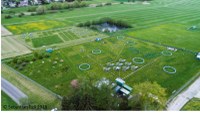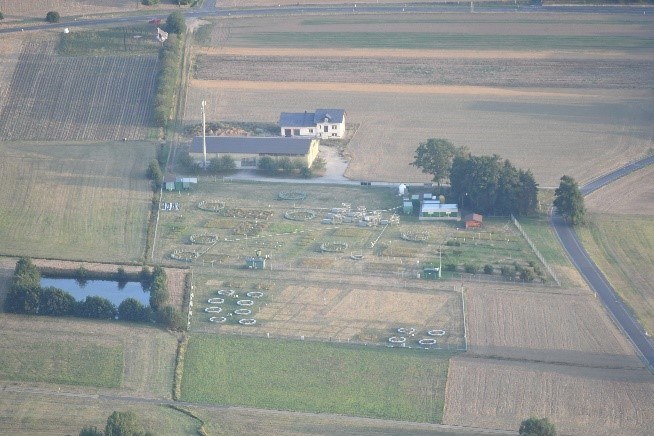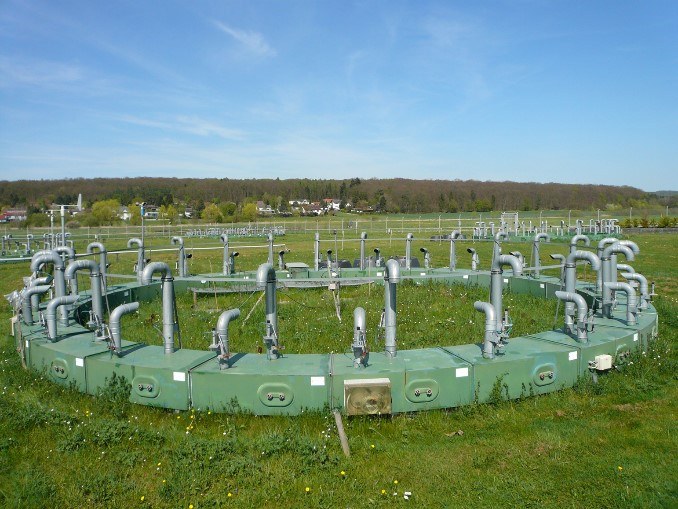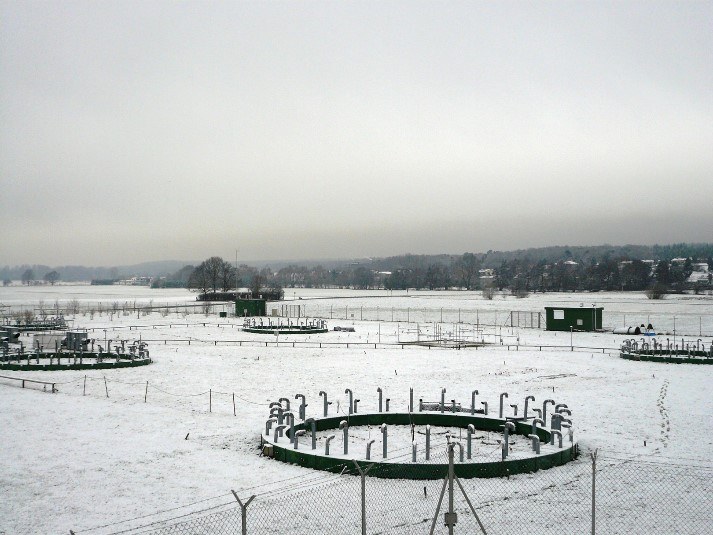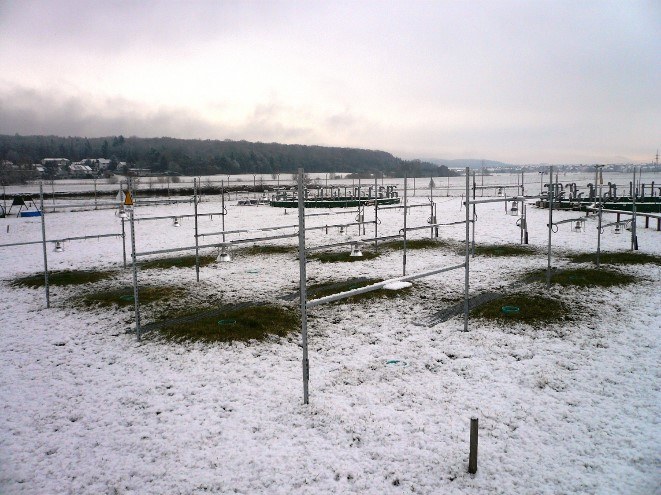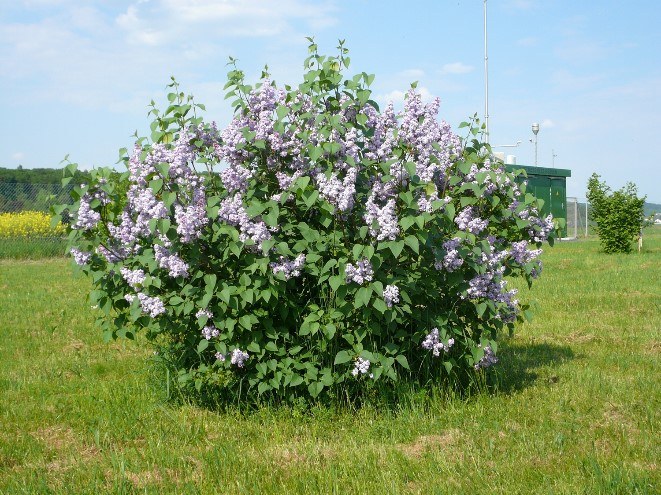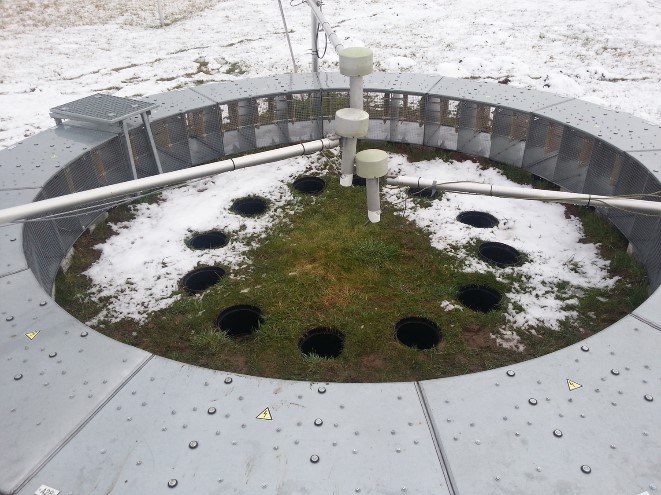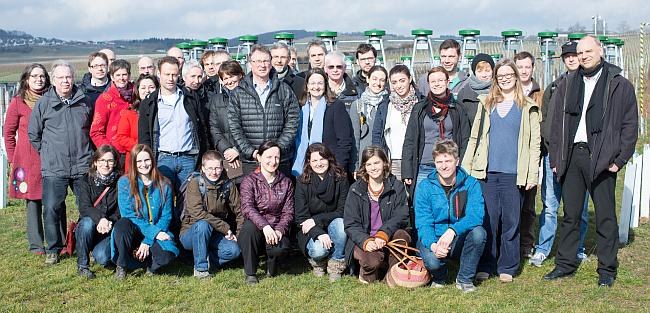Institute for Plant Ecology
Institute for Plant Ecology
We investigate the effects of different abiotic environmental factors (e.g., raised CO2, ozone, salt stress) on plant communities starting at the plant leave and the site to ecosystems level (professorship for experimental plant ecology) and ending in global cycles of C and N (professorship for geoecology and modelling). The applied methods range from biochemical, ecophysiological and microbiological lab investigations about field investigations (e.g., vegetation surveys, measurement of trace gas fluxes at site and ecosystem level) up to process oriented modelling and global models.
Institute for Plant Ecology
- Institute for Plant Ecology
-
We investigate the effects of different abiotic environmental factors (e.g., raised CO2, ozone, salt stress) on plant communities starting at the plant leave and the site to ecosystems level (professorship for experimental plant ecology) and ending in global cycles of C and N (professorship for geoecology and modelling). The applied methods range from biochemical, ecophysiological and microbiological lab investigations about field investigations (e.g., vegetation surveys, measurement of trace gas fluxes at site and ecosystem level) up to process oriented modelling and global models.
Experimental Plant Ecology
Staff
|
|
Phone +49641 99- |
Room |
|
Executive Director |
||
|
35301 |
B433 |
|
|
Academic senior scientist |
||
| Moser, Gerald, Dr. |
35315 +49 (6403) 6099062 |
B435 B436 Research station Leihgestern |
| Koyro, Hans-Werner Prof. | 35313 | B427 |
|
Research Assistants |
||
| Dehn, Philipp | 35336/35322 | B432 |
| 35326 |
B426 |
|
| 35336/35322 | B432 | |
| 35326 | B426 | |
| Kleineidam, Kristina | 35320 | B429 |
| Grüters, Uwe Dr. | 35314 | B436 |
| Administrative and technical staff | ||
|
35301 |
B434 |
|
| Strasilla, Nicol | 35316 | L455a |
|
35325 |
L453 |
|
|
35327 |
L450 |
|
|
+49 (6403) 6099062 |
Research station Leihgestern |
|
|
+49 (6403) 6099062 |
Research station Leihgestern |
|
| Alumni | ||
| Grünhage, Ludger |
Research
DASIM
DASIM - Denitrification in Agricultural Soils: Integrated control and Modelling at various scales
Funding Agency: DFG // Duration: 2016 - 2023 // PI: Christoph Müller
Denitrification is the process of nitrate reduction which allows microbes to breathe under aerobic conditions, is a key process of reactive nitrogen from the soil as inert N2 returns to the atmosphere. The individual steps (NO3- -> NO2- -> NO -> N2O -> N2) are enzymatically controlled by a large number of pro- and eukaryotes. Active denitrifiers communities in soil exhibit distinct regulatory phenotypes (DRP), with characteristic control of individual reaction steps and end products. It is unclear whether DRPs are taxonomically fixed in denitrifiers and how much environmental conditions can change them. Although research on DRPs has been going on for over 100 years, denitrification rates and the emission of gaseous products still cannot be satisfactorily explained and predicted. While the influence of individual environmental conditions is already well understood, the complexity of the overall process with its complicated cellular regulation as a reaction to very variable factors in the soil matrix has not yet been clarified. Key parameters are the oxygen partial pressure in the soil, the content of organic material and its quality, the pH value and the composition of the microbial community, which in turn is determined by soil structure, soil chemistry and soil-plant interaction. In this project we aim to make quantitative predictions of denitrification rates as a function of soil microstructure, organic mass quality, DRPs and atmospheric boundary layer condition. We rely on the latest experimental and analytical methods (X-ray µCT, 15N tracing, NanoSIMS, microsensors, advanced flux detection, NMR spectroscopy, molecular methods including "next generation sequencing of functional gene transcripts") to achieve a very accurate spatial and temporal resolution of the process steps. Improved numerical methods and computer capacities will allow to integrate the results of the individual groups and to develop new denitrification models ranging from the microscale (phase 1) to the field scale (phase 2).
Research Station
Environmental Monitoring and Climate Change Impact Research Station Linden
Funding Agency: Hessian State Agency for Nature Conservation, Environment and Geology (HLNUG) // Duration: 2017 - 2029 // PI: Prof. Christoph Müller, PhD
A strategic partnership exists between the Hessian State Agency for Nature Conservation, Environment and Geology (HLNUG) and the Justus Liebig University of Giessen, which is documented by the signing of a framework agreement. In addition, the HLNUG was an important associated partner in the LOEWE funding for the FACE2FACE project. The HLNUG significantly supports the implementation of the scientific results of the climate impact research carried out at the Environmental Monitoring and Climate Impact Research Station Linden (UKL) since 1998. A further 3-year grant is intended to continue the work that has been carried out together since 1998. In addition to the continuation of long-term observations (phenology, permanent observation plots) and experiments (Giessen FACE, Biochar), the factors increased CO2 concentrations and increased air temperature will be considered within the framework of the newly constructed Giessen T-FACE facility. The surveys include the continuation of existing data series as well as the inclusion of new integrative analyses, which above all form the basis for the application for further collaborative research projects.
Link to report on permanent observation plots
Moser G, Müller C (2017) Results of the passive biomonitoring from 1998-2014 on Hessian permanent observation plots in extensively cultivated grasslands.
Project report: https://www.hlnug.de/themen/fachzentrum-klimawandel/publikationen.html
Plant Phenology
Funding Agency : Hessian State Agency for Nature Conservation, Environment and Geology (HLNUG) // Duration: 2004 - 2019 // PI: Prof. Dr. Ludger Grünhage
The first work on the study "Climate Change and Plant Phenology in Hesse" was carried out within the framework of INKLIM (Integrated Climate Protection Programme Hesse 2012) in the years 2004-2009.
Since 2009, the study "Climate Change and Plant Phenology in Hesse" has been continued as part of the research activities at the Environmental Observatory and Climate Impact Research Station Linden (UKL), which is jointly run by the Institute for Plant Ecology of the JLU Giessen and the Hessian State Agency for Nature Conservation, Environment and Geology.
Green Dairy
Funding Agency : LOEWE / Duration: 2022 - 2025 // PI: Dr. Gerald Moser
The industrialization of agriculture offers several fundamental problems. Decoupled material cycles with high nitrogen surpluses, greenhouse gas emissions, soil degradation and problems regarding animal welfare result. The "GreenDairy" project aims to optimize agricultural structures and to enable ecologically and economically sustainable farming. By the use of integrated animal-plant agricultural ecosystems gaps of decoupled material cycles are expected to be closed. Additionally, effects of different farming systems (low-input vs. high-input) are to be investigated.
The project draws on the research infrastructure of the organically managed Gladbacherhof, where a digitalized dairy farming system has been established. The digital animal recording, grazing control, feeding and milking robotics, which is enabled by this system, helps to compare low-input systems (mainly roughage) with high-input systems (high proportion of corn silage and concentrated feed). In addition, the project incorporates research in animal, plant, soil, and environmental sciences, as well as agricultural and food economics, to provide a comprehensive picture of the impacts of different systems.
The Institute of Plant Ecology participates in the project area "Environment" with the investigation of greenhouse gas emissions in arable and grassland areas. At this, the climate-relevant gases CO2, CH4 and N2O are recorded using soil air probes and static chambers and are quantified subsequently. The measurements will be carried out over three years so that each crop in the project's crop rotation and the respective previous crops can be taken into account. Both cropland and grassland are analyzed, comparing high- and low-input areas. Thus, the aim is to minimize the emission of climate-relevant gases by an optimized agricultural system.
BioNET
Multi-stage assessment of biobased negative emission technologies (BioNET)
Funding Agency : DLR // Duration: 2022 - 2024 // PI: Prof. Christoph Mueller, PhD
Negative emission technologies that use biomass and biogenic CO2 (biobased NETs) play a central role in net-zero policy strategies. Embedded in agricultural and forestry supply chains, biobased NETs offer numerous options, but they also compete with biomass material and energy use and therefore face large uncertainties about the feasibility of their deployment. However, the deployment of bio-based NETs in Germany has not yet been evaluated in a coherent and integrated manner, especially from the perspective of local and regional deployment.
The aim of the BioNET (Multi-level assessment of biomass-based NETs) project is to create a comprehensive knowledge base for and assess biobased NETs in Germany by combining novel social science research with state-of-the-art biomass competition modeling and trade-off analysis to support local and national decision makers: (1) we compile transparent and accessible information and data on biobased NET concepts tailored to the information needs of different stakeholders, such as energy utilities or public authorities, (2) we develop novel participatory approaches to explore societal and institutional feasibility, (3) we elaborate and evaluate national biobased NET scenarios, including techno-economic modeling and an assessment of trade-offs with respect to the different Sustainable Development Goals.
As a result, the project identifies the window of opportunity for biobased NETs in Germany and enables decision makers from local to national level as well as researchers to include and prioritize the implementation of biobased NETs in their scenarios and strategies, using appropriate dissemination formats (open data, guidelines, policy briefs, etc.).
FACE2FACE
Funding Agency: LOEWE-HMWK // Duration: 2014 - 2017 // Speaker: Prof. Christoph Müller, PhD
What are the consequences of climate change for Central European agriculture?
It is getting warmer - also in Hesse. What does climate change mean for Central European agriculture? In order to investigate the complex effects of carbon dioxide on plants, soils, microorganisms and insects, LOEWE's focus "FACE2FACE" combines two large open-air experimental facilities to form a research platform: the "Free Air Carbon Dioxide Enrichment" systems - FACE for short - at Justus Liebig University in Giessen and Geisenheim University of Applied Sciences. The FACE systems make it possible to regulate the carbon dioxide concentration on defined surfaces and thus simulate the expected state in the middle of the century. Based on their findings, the scientists hope to develop strategies for adapting to climate change and reducing its consequences. They will concentrate on the agricultural ecosystems of grassland, viticulture and vegetable growing, horticulture and fruit growing.
All information about Face2Face can be found here
ICONICA
To make Europe a climate-neutral continent by 2050 while ensuring food security, sustainable agricultural soil management practices must be introduced. Improved soil organic carbon (SOC) storage (sequestration) could reduce the increase in atmospheric CO2 concentration. The long-term sequestration of SOC depends on many factors, especially interactions with other nutrients. The coupled Carbon-Nitrogen-Phosphorus cycles mediate soil organic matter formation and turnover. Soil phosphorus (P) is a key nutrient for plant growth. Limiting P content can reduce plant and microbial biomass in the soil and affect the sequestration of SOC. Altered soil P content affects microbial composition and activity, which are thought to control certain transformation pathways in the soil carbon and nitrogen cycles and influence the stabilization of GHG emissions, SOC, and nutrients.
The "ICONICA" project (ICONICA: Impact of long-term phosphorus additions on Carbon sequestration and Nitrogen Cycling in Agricultural soils) is using a series of long-term experiments on phosphorus fertilization in the EU and New Zealand to investigate the impact of varying soil P availability on SOC sequestration and GHG emissions, as well as on the carbon-nitrogen cycle in soils. Soil microbial processes associated with varying P availability in managed grassland and cropland systems will be quantified to identify mechanisms for SOC and nitrogen sequestration.
At the Institute of Plant Ecology, stable isotope techniques (labeling with 13C and 15N) are being applied in laboratory experiments to determine how long-term management of P fertilizers at different intensities controls soil C and N cycling and associated greenhouse gas emissions. The climate-relevant fluxes of the greenhouse gases N2O and CO2 from soils are measured. C and N dynamics will be assessed as a function of long-term P fertilization at different intensities. Results of 15N tracing will be matched with associated N2O emissions and C transformations to determine soil C losses and potential C stabilization affected by long-term P fertilization. Data generated by ICONICA will be used to determine optimal soil P levels and corresponding fertilizer recommendations for farmers that include optimal SOC sequestration and minimization of GHG emissions while maintaining crop yields of various agricultural soils.
Experimental Plant Ecology
- Experimental plant ecology
-
The main focus of the Experimental Plant Ecology Department is the climate change impact research. In long-term field experiments at the “Environmental Monitoring and Climate Change Impact Research Station Linden” we study plant and ecosystem reactions on climate change. In our Phenological Garden we observe changes in the plant phenology as a reaction on higher air temperature. In climate change manipulation experiments we investigate the reactions of plants and ecosystems on elevated atmospheric CO2 concentrations and higher air temperature. Since 1998 grassland plots are exposed to +20% higher CO2 concentrations compared to ambient (Giessen FACE = Free Air CO2 Enrichment) and we investigate changes in the species composition, plant growth, ecosystem fluxes of carbon and nitrogen, including greenhouse gas fluxes of CO2, CH4 and N2O, and many other parameters. In an additional experiment the temperature of soil and plant surfaces was heated (IR-Lamp Experiment). In an actual experiment we increase the air temperature directly in combination with elevated CO2 concentration and study the ecosystem responses (Giessen T-FACE = air Temperature warming and Free Air CO2 Enrichment).
One important result of the Giessen FACE is the doubling of N2O emissions under elevated CO2 and therefore one important research focus is to understand the responsible processes and nitrogen transformations in the soil, which is part of the research group DASIM (Denitrification in Agricultural Soils: Integrated control and Modelling at various scales).
In a Biochar Field Experiment we test if CO2 assimilated by plants and transformed into a stable carbon form as plant charcoal can be established as a climate change mitigations strategy to reduce the atmospheric CO2 concentration storing the stable carbon form long-term in agricultural soil. Additional investigations on anthropogenic Amazonian Terra Preta Soils are conducted for a better understanding of the positive effect of black carbon (plant charcoal) in tropical soils. Analogous, we study temperate historical killen soils created through charcoal burning.
Additional research questions are the investigation of Nutrient- and Energy-Exchange between the Phytosphere and the Atmosphere, as the atmospheric N deposition or the exchange of ozone.
Experimental plant ecology
The main focus of the Experimental Plant Ecology Department is the climate change impact research. In long-term field experiments at the “Environmental Monitoring and Climate Change Impact Research Station Linden” we study plant and ecosystem reactions on climate change. In our Phenological Garden we observe changes in the plant phenology as a reaction on higher air temperature. In climate change manipulation experiments we investigate the reactions of plants and ecosystems on elevated atmospheric CO2 concentrations and higher air temperature. Since 1998 grassland plots are exposed to +20% higher CO2 concentrations compared to ambient (Giessen FACE = Free Air CO2 Enrichment) and we investigate changes in the species composition, plant growth, ecosystem fluxes of carbon and nitrogen, including greenhouse gas fluxes of CO2, CH4 and N2O, and many other parameters. In an additional experiment the temperature of soil and plant surfaces was heated (IR-Lamp Experiment). In an actual experiment we increase the air temperature directly in combination with elevated CO2 concentration and study the ecosystem responses (Giessen T-FACE = air Temperature warming and Free Air CO2 Enrichment).
One important result of the Giessen FACE is the doubling of N2O emissions under elevated CO2 and therefore one important research focus is to understand the responsible processes and nitrogen transformations in the soil, which is part of the research group DASIM (Denitrification in Agricultural Soils: Integrated control and Modelling at various scales).
In a Biochar Field Experiment we test if CO2 assimilated by plants and transformed into a stable carbon form as plant charcoal can be established as a climate change mitigations strategy to reduce the atmospheric CO2 concentration storing the stable carbon form long-term in agricultural soil. Additional investigations on anthropogenic Amazonian Terra Preta Soils are conducted for a better understanding of the positive effect of black carbon (plant charcoal) in tropical soils. Analogous, we study temperate historical killen soils created through charcoal burning.
Additional research questions are the investigation of Nutrient- and Energy-Exchange between the Phytosphere and the Atmosphere, as the atmospheric N deposition or the exchange of ozone.
FACE2FACE
FACE2FACE
- FACE2FACE
-
Impacts of Climate Change, Adaptation to Climate Change and Reduction of Greenhouse Gas Emissions until 2050
Welcome to the Website of the LOEWE Research Center
(LOEWE is a research fund for the development of scientific and economic excellence of the federal state Hessian)
What are the Impacts of Climate Change on Central European Agriculture?
It is getting warmer – in Hessian, too. How is central European agriculture affected by climate change? In order to examine the complex effects of carbon dioxide on plants, soils, microorganisms and insects, the LOEWE research center FACE2FACE combines two large-scale field research facilities: The Free Air Carbon Dioxide Enrichment systems (FACE) of the Justus Liebig University Giessen and the FACE systems of the Hochschule Geisenheim University. These FACE systems enable us to increase the atmospheric carbon dioxide concentration on experimental plots to a predefined level and thus to simulate conditions predicted for the middle of the century. Based on the knowledge gained in their studies, researchers will develop strategies for the adaptation to climate change or for the mitigation of climate change impacts. The research activities focus on the agroecosystems grassland vineyard and vegetable field
- News
-
In the following you find Current Dates and Highlights within the Framework of FACE2FACE:
FACE2FACE
Impacts of Climate Change, Adaptation to Climate Change and Reduction of Greenhouse Gas Emissions until 2050
Welcome to the Website of the LOEWE Research Center
(LOEWE is a research fund for the development of scientific and economic excellence of the federal state Hessian)
What are the Impacts of Climate Change on Central European Agriculture?
It is getting warmer – in Hessian, too. How is central European agriculture affected by climate change? In order to examine the complex effects of carbon dioxide on plants, soils, microorganisms and insects, the LOEWE research center FACE2FACE combines two large-scale field research facilities: The Free Air Carbon Dioxide Enrichment systems (FACE) of the Justus Liebig University Giessen and the FACE systems of the Hochschule Geisenheim University. These FACE systems enable us to increase the atmospheric carbon dioxide concentration on experimental plots to a predefined level and thus to simulate conditions predicted for the middle of the century. Based on the knowledge gained in their studies, researchers will develop strategies for the adaptation to climate change or for the mitigation of climate change impacts. The research activities focus on the agroecosystems grassland vineyard and vegetable field
Staff
Staff
| Speaker | |
| Müller, Christoph, Prof., PhD | JLU Gießen |
| Coordination | |
| Luterbacher, Jürg, Prof., PhD | JLU Gießen |
| Müller, Christoph, Prof., PhD | JLU Gießen |
| Schultz, Hans-Reiner, Prof. Dr. | HS Geisenheim |
| Steering Group | |
| Breuer, Lutz, Dr. | JLU Gießen |
| Grünhage, Ludger, Prof. Dr. | JLU Gießen |
| Hemfler, Marion, Dr. | HLUG |
| Löhnertz, Otmar, Prof. Dr. | HS Geisenheim |
| Luterbacher, Jürg, Prof., PhD | JLU Gießen |
| Müller, Christoph, Prof., PhD | JLU Gießen |
| Schmid, Thomas, Prof. Dr. | HLUG |
| Schultz, Hans-Reiner, Prof. Dr. | HS Geisenheim |
| Principal Investigators | |
| Bendix, Jörg, Prof. Dr. | PU Marburg |
| Berkelmann-Löhnertz, Beate, Prof. Dr. | HS Geisenheim |
| Breuer, Lutz, Dr. | JLU Gießen |
| Dietrich, Helmut, Prof. Dr. | HS Geisenheim |
| Grünhage, Ludger, Prof. Dr. | JLU Gießen |
| Hemfler, Marion, Dr. | HLUG |
| Kahlen, Katrin, Dr. | HS Geisenheim |
| Kämpfer, Peter, Prof. Dr. | JLU Gießen |
| Kogel, Karl-Heinz, Prof. Dr. | JLU Gießen |
| Liesack, Werner, Dr. | MPI Marburg |
| Löhnertz, Otmar, Prof. Dr. | HS Geisenheim |
| Luterbacher, Jürg, Prof., PhD | JLU Gießen |
| Müller, Christoph, Prof., PhD | JLU Gießen |
| Otte, Annette, Prof. Dr. Dr. | JLU Gießen |
| Reineke, Annette, Prof. Dr. | HS Geisenheim |
| Schmid, Thomas, Prof. Dr. | HLUG |
| Schnell, Sylvia, Prof. Dr. | JLU Gießen |
| Schultz, Hans-Reiner, Prof. Dr. | HS Geisenheim |
| Stoll, Manfred, Dr. | HS Geisenheim |
| Wissemann, Volker, Prof. Dr. | JLU Gießen |
| Ziemek, Hans-Peter, Prof. Dr. | JLU Gießen |
| Zinkernagel, Jana, Prof. Dr. | HS Geisenheim |
| Scientific Staff and PhD Students | |
| Berlebach, Antje | HS Geisenheim |
| Cevik, Ebru | JLU Gießen |
| Eiserlo, Felix | HS Geisenheim |
| Erbs, Martin, Dr. | JLU Gießen |
| Guillet, Cécile | JLU Gießen |
| Kellner, Juliane | JLU Gießen |
| Klostermann, Hannah-Rebecca | HS Geisenheim |
| Liebermann, Ralf | JLU Gießen |
| Maisinger, Corinna | JLU Gießen |
| Obermeier, Wolfgang | PU Marburg |
| Schlering, Christine | HS Geisenheim |
| Seibert, Ruben | JLU Gießen |
| Selim, Moustafa, Dr. | HS Geisenheim |
| Wohlfahrt, Yvette | HS Geisenheim |
| Wu, Xiaohung, Dr. | MPI Marburg |
| Yuan, Naiming, Dr. | JLU Gießen |
| Technical and Administrative Assistants | |
| Seehawer, Lara | JLU Gießen |
| Lenz, Birte | JLU Gießen |
| Strohbusch, Till | JLU Gießen |
| Strasilla, Nicol | JLU Gießen |
| Mayer, Gerhard | JLU Gießen |
Staff
- Staff
-
Speaker Müller, Christoph, Prof., PhD JLU Gießen Coordination Luterbacher, Jürg, Prof., PhD JLU Gießen Müller, Christoph, Prof., PhD JLU Gießen Schultz, Hans-Reiner, Prof. Dr. HS Geisenheim Steering Group Breuer, Lutz, Dr. JLU Gießen Grünhage, Ludger, Prof. Dr. JLU Gießen Hemfler, Marion, Dr. HLUG Löhnertz, Otmar, Prof. Dr. HS Geisenheim Luterbacher, Jürg, Prof., PhD JLU Gießen Müller, Christoph, Prof., PhD JLU Gießen Schmid, Thomas, Prof. Dr. HLUG Schultz, Hans-Reiner, Prof. Dr. HS Geisenheim Principal Investigators Bendix, Jörg, Prof. Dr. PU Marburg Berkelmann-Löhnertz, Beate, Prof. Dr. HS Geisenheim Breuer, Lutz, Dr. JLU Gießen Dietrich, Helmut, Prof. Dr. HS Geisenheim Grünhage, Ludger, Prof. Dr. JLU Gießen Hemfler, Marion, Dr. HLUG Kahlen, Katrin, Dr. HS Geisenheim Kämpfer, Peter, Prof. Dr. JLU Gießen Kogel, Karl-Heinz, Prof. Dr. JLU Gießen Liesack, Werner, Dr. MPI Marburg Löhnertz, Otmar, Prof. Dr. HS Geisenheim Luterbacher, Jürg, Prof., PhD JLU Gießen Müller, Christoph, Prof., PhD JLU Gießen Otte, Annette, Prof. Dr. Dr. JLU Gießen Reineke, Annette, Prof. Dr. HS Geisenheim Schmid, Thomas, Prof. Dr. HLUG Schnell, Sylvia, Prof. Dr. JLU Gießen Schultz, Hans-Reiner, Prof. Dr. HS Geisenheim Stoll, Manfred, Dr. HS Geisenheim Wissemann, Volker, Prof. Dr. JLU Gießen Ziemek, Hans-Peter, Prof. Dr. JLU Gießen Zinkernagel, Jana, Prof. Dr. HS Geisenheim Scientific Staff and PhD Students Berlebach, Antje HS Geisenheim Cevik, Ebru JLU Gießen Eiserlo, Felix HS Geisenheim Erbs, Martin, Dr. JLU Gießen Guillet, Cécile JLU Gießen Kellner, Juliane JLU Gießen Klostermann, Hannah-Rebecca HS Geisenheim Liebermann, Ralf JLU Gießen Maisinger, Corinna JLU Gießen Obermeier, Wolfgang PU Marburg Schlering, Christine HS Geisenheim Seibert, Ruben JLU Gießen Selim, Moustafa, Dr. HS Geisenheim Wohlfahrt, Yvette HS Geisenheim Wu, Xiaohung, Dr. MPI Marburg Yuan, Naiming, Dr. JLU Gießen Technical and Administrative Assistants Seehawer, Lara JLU Gießen Lenz, Birte JLU Gießen Strohbusch, Till JLU Gießen Strasilla, Nicol JLU Gießen Mayer, Gerhard JLU Gießen
Publications
Publications
These are the peer-reviewed publications, which resulted from the LOEWE research center FACE2FACE:
- Gómez-Navarro JJ, Bothe O, Wagner S, Zorita E, Werner JP, Luterbacher J, Raible CC, Montávez JP (2015) A regional climate palaeo simulation for Europe in the period 1500–1990 – Part 2: Shortcomings and strengths of models and reconstructions. Climate of the Past 11: 1077–1095. DOI: 10.5194/cp-11-1077-2015
- Haworth M, Moser G, Raschi A, Kammann C, Grünhage L, Müller C (2016) Carbon dioxide fertilisation and supressed respiration induce enhanced spring biomass production in a mixed species temperate meadow exposed to moderate carbon dioxide enrichment. Functional Plant Biology 43: 26–39. DOI: 10.1071/FP15232
- Hofmann M, Lux R and Schultz HR (2014) Constructing a framework for risk analyses of climate change effects on the water budget of differently sloped vineyards with a numeric simulation using the Monte Carlo method coupled to a water balance model. Frontiers of Plant Science 5: 645, 1-22. DOI: 10.3389/fpls.2014.00645
- Houska T, Kraft P, Chamorro-Chavez A, Breuer L (submitted) SPOTting Model Parameters Using a ready-made Python Package. PLoS ONE 10(12): e0145180. DOI: 10.1371/journal.pone.0145180
- Kahlen K, Chen T‐W, Zinkernagel J (2015) Towards virtual plant modelling as a tool in climate change impact research. Procedia Environmental Sciences 29: 245‐246. DOI: 10.1016/j.proenv.2015.07.294
- Karbin S, Guillet C, Kammann CI, Niklaus PA (2015) Effects of long-term CO2 Enrichment on soil-atmosphere CH4 fluxes and the spatial micro-distribution of methanotrophic bacteria. PLoS ONE 10(7):e0131665. DOI: 10.1371/journal.pone.0131665
- Keidel L, Kammann C, Grünhage L, Moser G, Müller C (2015) Positive feedback of elevated CO2 on soil respiration in late autumn and winter. Biogeosciences 12: 1257-1269. DOI: 10.5194/bg-12-1257-2015
- Kellner J, Multsch S, Kraft P, Houska T, Mueller C, Breuer L (2015) Uncertainty analyses of a coupled hydrologicalplant growth model for grassland under elevated CO2. Procedia Environmental Sciences 29: 79-80. DOI: 10.1016/j.proenv.2015.07.168
- Klostermann HR, Zinkernagel J, Kahlen K (2015) Geisenheim FACE for Vegetable Crops ‐ Methodological Framework. Procedia Environmental Sciences 29, 106. DOI: 10.1016/j.proenv.2015.07.184
- Luterbacher J, Werner JP, Smerdon JE, Fernández-Donado L, González-Rouco FJ, Barriopedro D, Ljungqvist FC, Büntgen U, Zorita E, Wagner S, Esper J, McCarroll D, Toreti A, Frank D, Jungclaus JH, Barriendos M, Bertolin C, Bothe O, Brázdil R, Camuffo D, Dobrovolný P, Gagen M, García-Bustamante E, Ge Q, Gómez-Navarro JJ, Guiot J, Hao Z, Hegerl GC, Holmgren K, Klimenko VV, Martín-Chivelet V, Pfister C, Roberts N, Schindler A, Schurer A, Solomina O, von Gunten L, Wahl E, Wanner H, WetterO, Xoplaki E, Yuan N, Zanchettin D, Zhang H, Zerefos C (2016) European summer temperatures since Roman times. Environmental Research Letters 11: 1-12. DOI: 10.1088/1748-9326/11/2/024001
- Müller C, Laughlin RJ, Spott O, Rütting T (2014). Quantification of N2O emission pathways via a 15N tracing model. Soil Biology & Biochemistry 72, 44-54. DOI: 10.1016/j.soilbio.2014.01.013
- Rütting T, Andresen LC (2015) Nitrogen cycle responses to elevated CO2 depend on ecosystem nutrient status. Nutrient Cycling in Agro Ecosystems. DOI: 10.1007/s10705-015-9683-8.
- Selim M, Berkelmann-Löhnertz B, Kogel K-H, Reineke A (2015) Plant-pest interactions under elevated CO2 concentration in the system grapevine (Vitis vinifera) - downy mildew (Plasmopara viticola) - grape berry moth (Lobesia botrana). Procedia Environmental Sciences 29: 135-136. DOI: 10.1016/j.proenv.2015.07.225
- Wohlfahrt Y, Tittmann S, Stoll M (2015) Towards adaption to Free Air Carbon dioxide Enrichment (FACE): Preliminary results on physiology of Vitis vinifera L. cv. Riesling. 19th International Meeting of Viticulture GiESCO Proceedings Volume 1, 76-80.
- Yuan N, Ding M, Huang Y, Fu Z, Xoplaki E, Luterbacher J (2015) On the long-term climate memory in the surface air temperature records over Antarctica: A non-negligible factor for trend evaluation. Journal of Climate 28: 5922–5934. DOI: http://dx.doi.org/10.1175/JCLI-D-14-00733.1
- Zhang H, Yuan N, Xoplaki E, Werner J, Büntgen U, Esper J, Treydte K, Luterbacher J (2015) Modified climate with long term memory in tree ring proxies. Environmental Research Letters 10: 1-15. DOI: 10.1088/1748-9326/10/8/084020Modified climate with long term memory in tree ring proxies. Environ. Res. Lett., 10 084020.
-
Chen, Z., J. Zhang, Z. Xiong, G. Pan, and C. Müller. 2016. Enhanced gross nitrogen transformation rates and nitrogen supply in paddy field under elevated atmospheric carbon dioxide and temperature. Soil Biology & Biochemistry 94:80-87.
Overview of climate change relevant homepages
|
Links on current data and visualisations |
|
Climate, Weather and Environmental Agencies |
|
The Intergovernmental Panel on Climate Change |
|
The Intergovernmental Science-Policy Platform on |
|
The World Meteorolgical Organization (WMO) |
|
The United Nations Environment Programme |
|
. The National Oceanic and Atmospheric |
|
sos.noaa.gov/datasets/catalog/datasets/water?Display=list&ordering=-DateAdded |
|
The National Aeronautics and Space Administration (NASA) provides many data, visualisations and video clips on air, climate, hazards, water, oceans and ice etc. |
|
|
|
|
The European Environment Agency (EEA) provides detailed data and maps about the EU related to climate change: |
|
www.eea.europa.eu/data-and-maps/data/data-viewers/eea-greenhouse-gas-projections-data-viewer |
|
The Joint Research Center of the European Union provides environmental and climate change |
|
ec.europa.eu/jrc/en/science-area/environment-and-climate-change |
|
National Snow & Ice Data Center (NSIDC) provides data and visualisations on snow cover, glaciers, ice sheets, sea ice, ice shelves, soil moisture and frozen ground: |
|
The Food and Agriculture Organization of the |
|
The German Weather Service (DWD) provides |
|
The UFZ-Dürremonitor provides daily |
|
Das Hessische Landesamt für Naturschutz, Umwelt und Geologie (HLNUG) liefert umfangreiche Umwelt-Daten für Hessen: |
The Hessian State Agency for Nature Conservation, Environment and Geology (HLNUG) provides extensive environmental data for Hessen: |
|
www.hlnug.de/themen/geografische-informationssysteme/gis-anwendungen/gis-auskunftssysteme |
|
More on historical and future weather and climate data: |
https://datagraver.com/case/kyoto-cherry-blossom-full-flower-dates
|
With Earth Nullschool you can dynamically display atmospheric currents from the earth's surface to the tropopause (Jetstream). Additional data can be displayed for temperature, humidity, cloud water content, CO2 content. Sea currents can also be visualised |
|
|
|
The Fluid Earth Viewer allows current and past |
|
The goal of the Climate Reanalyzer is to make key climate information – models and station data – readily available to everyone. |
|
At Sea Temperature.org you get the current and |
|
The Terrestrial Precipitation Analysis Packages |
|
drought-net.colostate.edu/terrestrial-precipitation-analysis-package |
|
The Global Terrestrial Network for Permafrost |
|
|
|
WorldClim provides historic, recent and future |
How do climate models work?
https://www.carbonbrief.org/qa-how-do-climate-models-work
|
More on historical and future Greenhouse |
|
Climate Spirals and Tornados are impressive |
|
www.usgs.gov/media/images/simulated-global-temperature-change-0 |
|
openclimatedata.net/climate-spirals/from-emissions-to-global-warming-line-chart/ |
|
The Global Carbon Project integrates knowledge of greenhouse gases for human activities and the |
|
https://www.globalcarbonproject.org/carbonbudget/19/visualisations.htm |
|
The Atmosphere Monitoring Service of Copernicus displays actual emissions of and CH4 and other pollutants |
|
|
|
Puls provides a global methane emission |
|
Climate Watch offers open data, visualizations and analysis to help policymakers, researchers and other stakeholders gather insights on countries' climate progress: |
|
The Climate Action Tracker is an independent |
|
The Production Gap Report measures the gap |
|
The Greenhouse Gas Management Institute involves educating on the basics of GHG accounting, auditing and management, training professionals to meet the |
|
Open Climate Data provides data resources on Global carbon cycle and emissions data, including fossil-fuel, cement, and land-use change emissions, atmospheric growth, and ocean and land sinks. It also gives access agreement status and National Climate Plans: |
|
On Our World in Data.org you can find data on |
|
Worldometer is run by an international team of |
|
Fire Monitoring and Ecosystem and Biodiversity Loss |
|
|
Fire Information for Resource Management System (FIRMS) provides satellite global data on fire events: |
|
firms.modaps.eosdis.nasa.gov/map/#t:adv;d:2019-08-23..2019-08-24;l:viirs,modis_a,modis_t;@0.0,0.0,3z |
|
The Amazon Dashboard tracks individual fires in the Amazon region using a new approach to cluster and classify active fire detections by fire type: |
|
Global Forest Watch offers the latest data, |
|
Global Forest Change results from time-series |
|
Global Soil Biodiversity Initiative is seeking to |
|
Global Soil Partnership and Intergovernmental Technical Panel on Soils (ITPS) addressing sustainable soil management in the different sustainable development agendas |
|
|
|
|
|
|
|
|
|
|
|
Audubon Society - Survival by Degree shows for North American bird species how the range is expected to change under different climate scenarios. |
|
|
|
|
Potential Strategies and Solutions for global change mitigation and adaptations |
https://unfccc.int/climate-action/marrakech-partnership/reporting-and-tracking
|
The World Resource Institute (WRI) focuses on |
|
Resource Watch provides trusted and timely data for a sustainable future: |
|
The Global Safety Net developed the first global- |
|
The Crowther Lab Restoration app wants to connect ecological science with applied ecosystem restoration: |
|
The Alliance for Zero Extinction (AZE) engages governments, multilateral institutions and non-governmental biodiversity conservation organizations (see list of AZE members) working to prevent species extinctions: |
|
www.arcgis.com/home/webmap/viewer.html?webmap=4ecca6a29bf142338e459e27ade152c8 |
|
Interactive stories about the climate crisis |
|
CNN offers elaborately designed and interactive press features on climate change, climate feedbacks and deforestation. |
|
https://edition.cnn.com/interactive/2020/12/world/ticking-time-bomb/ |
|
https://edition.cnn.com/interactive/2019/11/asia/borneo-climate-bomb-intl-hnk/ |
|
Spiegel Online creates a multimedia series on |

